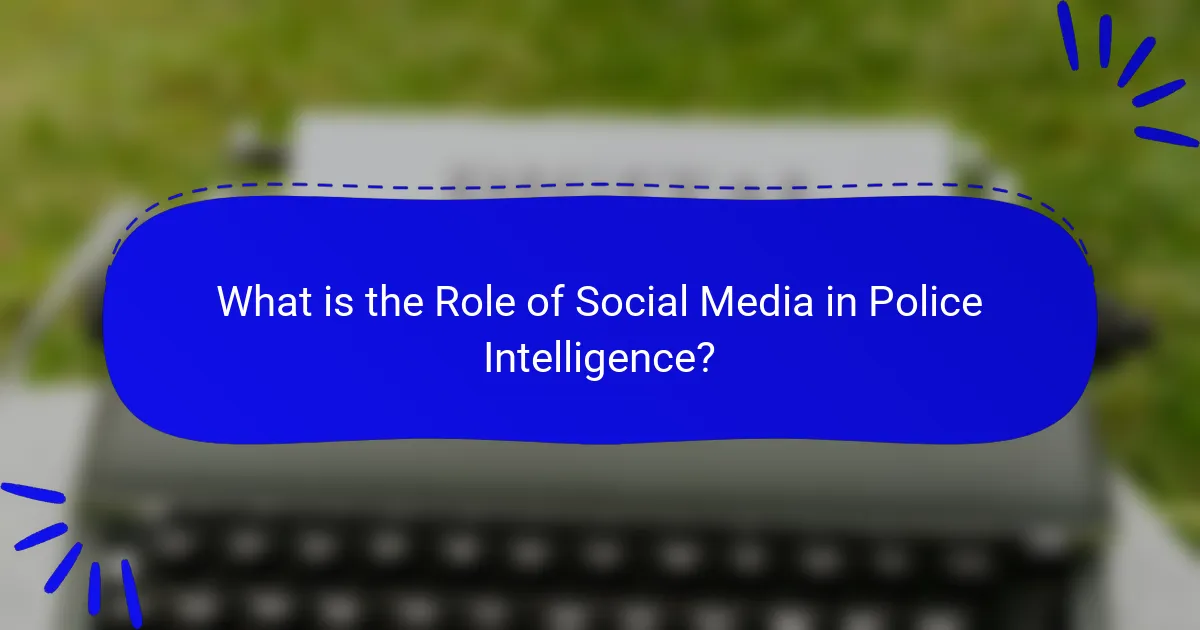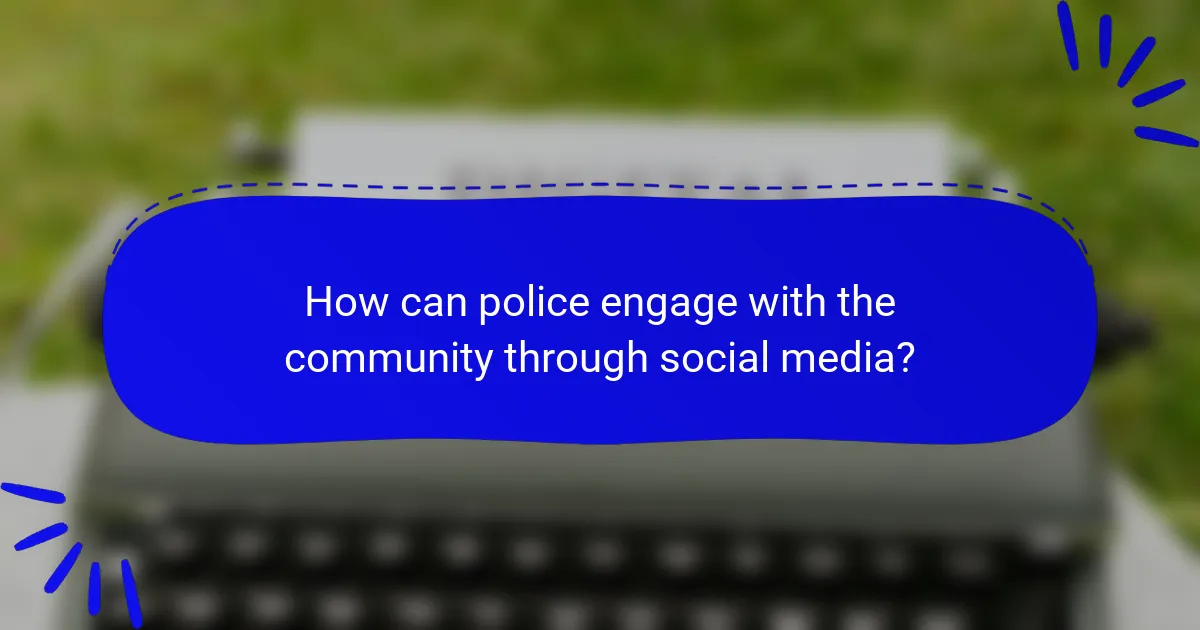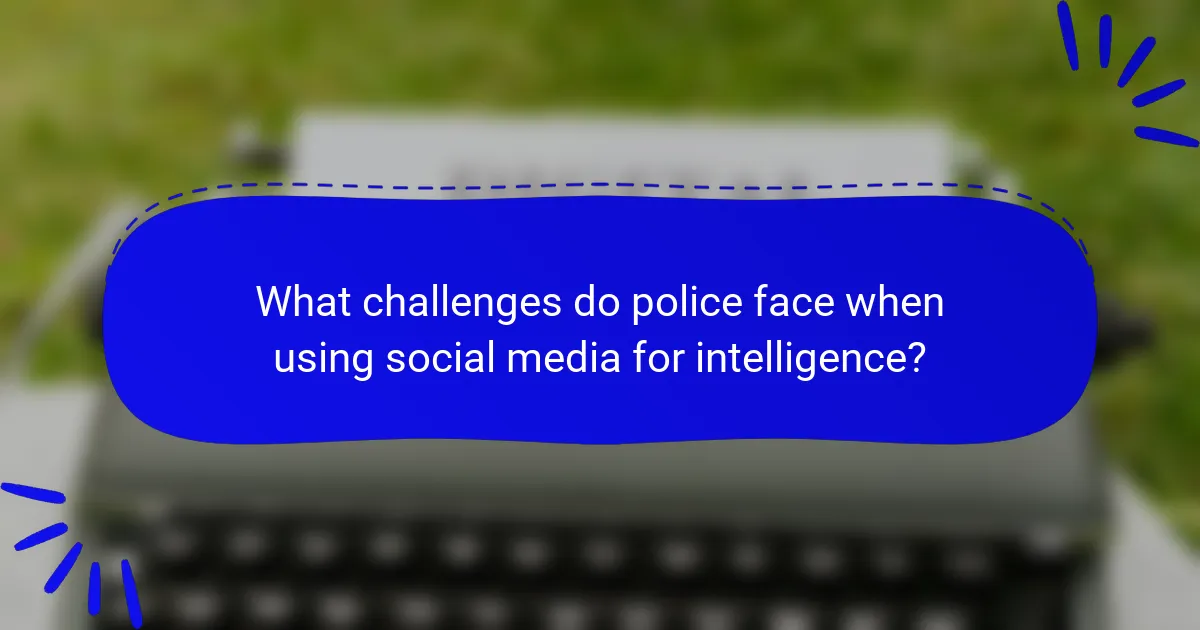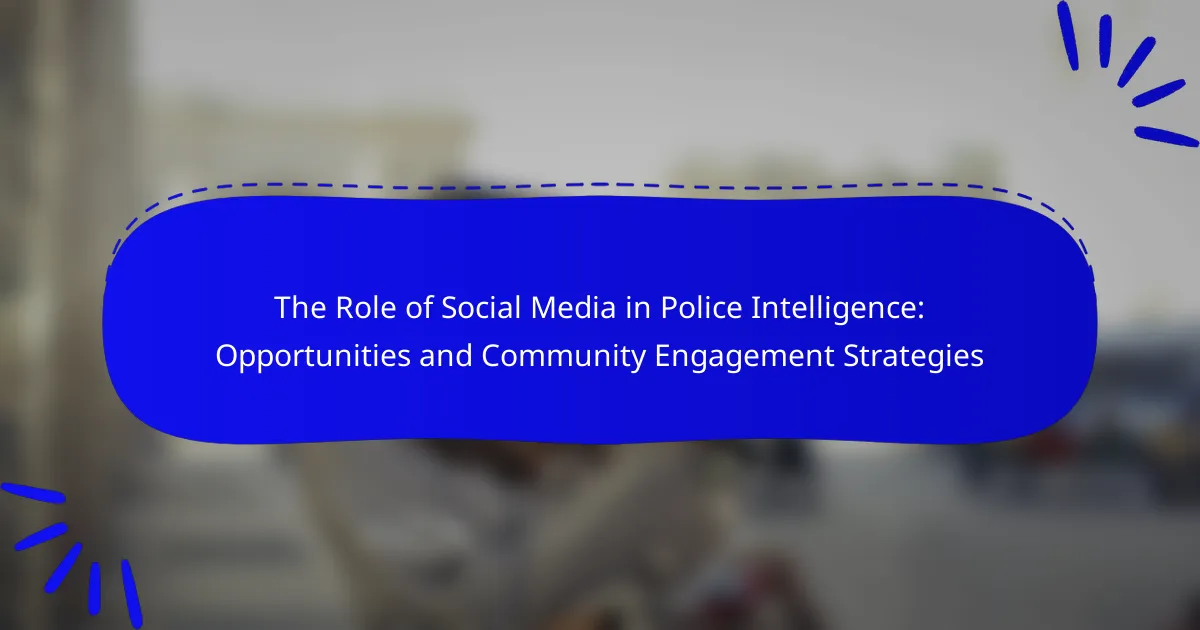
What is the Role of Social Media in Police Intelligence?
Social media plays a crucial role in police intelligence by facilitating real-time information sharing. It allows law enforcement agencies to gather intelligence from public posts, aiding in crime prevention and investigation. Social media platforms serve as valuable tools for monitoring trends and public sentiment. They enable police to engage with the community, enhancing trust and collaboration. Additionally, social media can assist in identifying suspects through user-generated content. A 2019 study revealed that 75% of police departments utilize social media for intelligence purposes. This integration of social media enhances situational awareness and response effectiveness in policing.
How is social media currently utilized by police departments?
Police departments currently utilize social media for communication, community engagement, and crime prevention. They share information about ongoing investigations and public safety alerts. Social media platforms allow police to connect with the community in real-time. Departments also use these platforms to solicit tips and gather information from the public. Additionally, social media helps in building trust and transparency with citizens. Studies show that effective social media use can enhance public perception of law enforcement. For instance, a survey by the International Association of Chiefs of Police found that 81% of departments use social media for community engagement.
What types of information can police gather from social media platforms?
Police can gather various types of information from social media platforms. This includes user-generated content such as posts, comments, and images. They can analyze location data from geotagged posts. Police can track interactions and relationships between users. They can also monitor public discussions related to criminal activity. Additionally, police may gather evidence of threats or illegal behavior. Social media can provide insights into community sentiments and trends. This information aids in investigations and enhances public safety. Data from social media has been used in numerous criminal investigations, demonstrating its value.
How do police analyze social media data for intelligence purposes?
Police analyze social media data for intelligence purposes by employing various techniques and tools. They monitor public posts to gather information on criminal activities. Advanced algorithms help in identifying patterns and trends in user behavior. Law enforcement agencies often use social media analytics software for real-time monitoring. This software can track keywords, hashtags, and locations relevant to investigations. Data mining techniques assist in extracting valuable insights from large volumes of social media content. Additionally, police may collaborate with social media platforms to access user data when necessary. Research indicates that social media can provide crucial leads in ongoing investigations, enhancing situational awareness for law enforcement.
What opportunities does social media provide for police intelligence?
Social media provides police intelligence with real-time information gathering. It allows law enforcement to monitor public sentiment and identify potential threats. Social media platforms serve as a tool for community engagement and information sharing. They enable police to disseminate alerts and updates quickly. Analysis of social media data can reveal crime patterns and trends. Many departments use social media for crowd monitoring during events. This can enhance situational awareness and response strategies. Reports indicate that 90% of police agencies utilize social media for intelligence purposes.
How can social media enhance communication between police and the community?
Social media enhances communication between police and the community by providing real-time information sharing. It allows police departments to disseminate updates quickly during emergencies. For instance, platforms like Twitter enable immediate alerts about public safety threats. Community members can also engage directly with police through comments and messages. This interaction fosters transparency and trust. Studies have shown that police departments using social media report improved community relations. Additionally, social media can be used for community outreach initiatives and events. This creates opportunities for collaboration between law enforcement and citizens.
What role does social media play in crime prevention and investigation?
Social media plays a significant role in crime prevention and investigation. It serves as a platform for law enforcement agencies to disseminate information quickly. Police can share alerts about ongoing criminal activity or missing persons. This immediate communication can engage the public in reporting suspicious behavior.
Social media also facilitates community engagement. It allows for direct interaction between citizens and law enforcement. This interaction can help build trust and encourage community members to cooperate with investigations.
Data from the Pew Research Center indicates that 70% of adults use social media. This high usage provides a vast audience for police communications. Furthermore, social media can be a valuable tool for gathering evidence. Investigators can analyze posts, images, and videos related to criminal incidents.
Studies have shown that social media can enhance situational awareness during emergencies. For example, during the 2013 Boston Marathon bombing, social media played a crucial role in sharing information. This use of social media can lead to faster identification and apprehension of suspects.
Overall, social media enhances crime prevention strategies and aids investigations through timely information sharing and community collaboration.

How can police engage with the community through social media?
Police can engage with the community through social media by sharing information and updates. This includes posting about local events, crime alerts, and safety tips. They can also encourage community feedback through polls and comments. Responding to community inquiries demonstrates openness and builds trust. Additionally, police can highlight community partnerships and initiatives. Sharing success stories fosters a positive image. Utilizing live video for Q&A sessions allows direct interaction. Engaging with local issues shows commitment to community concerns. These strategies enhance transparency and strengthen community relationships.
What strategies can be implemented for effective community engagement?
Effective community engagement strategies include utilizing social media platforms for communication. Social media allows police to share information quickly and transparently. Engaging with community members through posts fosters trust and collaboration. Regularly hosting online forums encourages dialogue and feedback. Implementing targeted outreach initiatives can address specific community concerns. Utilizing data analytics helps identify engagement trends and areas for improvement. Partnering with local organizations enhances outreach efforts and builds relationships. Training officers in social media use ensures consistent and effective communication.
How can police departments create informative and engaging social media content?
Police departments can create informative and engaging social media content by focusing on transparency and community interaction. They should share updates on local crime statistics and safety tips. Engaging visuals, such as infographics and videos, can enhance message retention. Hosting live Q&A sessions fosters direct communication with the community. Highlighting community events and initiatives builds a positive rapport. User-generated content, like testimonials or stories, encourages community participation. Regularly monitoring feedback helps refine content strategies. A study by the International Association of Chiefs of Police found that engaging social media use can improve public trust and cooperation.
What are best practices for responding to community inquiries on social media?
Best practices for responding to community inquiries on social media include being timely, respectful, and informative. Timely responses show community members that their concerns are valued. Respectful communication fosters trust and encourages further engagement. Providing informative answers helps clarify issues and enhances community understanding. Additionally, personalizing responses can create a connection with the audience. Monitoring social media regularly ensures that inquiries are addressed promptly. Using clear and concise language aids in effective communication. Lastly, acknowledging feedback, whether positive or negative, demonstrates that the organization values community input. These practices collectively enhance community relations and engagement.
How can police foster trust and transparency using social media?
Police can foster trust and transparency using social media by actively engaging with the community. They should share timely information about incidents, policies, and community events. Regular updates can demystify police work and build rapport. Police departments can also highlight positive interactions and community partnerships. Transparency in sharing data about crime statistics can enhance public trust. Utilizing platforms for direct communication allows citizens to voice concerns and ask questions. Engaging with community feedback shows that police value public input. According to a study by the International Association of Chiefs of Police, effective social media use can improve community perceptions of police legitimacy.
What initiatives can police take to educate the public about their social media use?
Police can implement various initiatives to educate the public about their social media use. They can conduct community workshops focused on safe social media practices. These workshops can cover privacy settings, recognizing misinformation, and reporting suspicious activity.
Police can also create informative social media campaigns. These campaigns can share tips and best practices for responsible online engagement. Engaging local influencers to spread awareness can enhance the reach of these campaigns.
Additionally, police can collaborate with schools to integrate social media education into the curriculum. This partnership can help teach students about the implications of their online actions.
Hosting Q&A sessions on social media platforms can encourage direct interaction with the community. These sessions can address concerns and clarify misconceptions about police presence online.
By utilizing these initiatives, police can foster a safer online environment and strengthen community trust.
How can police address concerns regarding privacy and data security on social media?
Police can address concerns regarding privacy and data security on social media by implementing strict data protection policies. These policies should ensure that personal information is handled responsibly and transparently. Regular training for officers on data privacy laws is essential. This training can help officers understand the implications of data misuse. Engaging with community stakeholders can also build trust. Public forums can be held to discuss privacy concerns. Additionally, police can utilize encryption methods to secure sensitive data. Compliance with regulations like GDPR can further enhance data security. These measures can help mitigate public fears regarding privacy on social media.

What challenges do police face when using social media for intelligence?
Police face several challenges when using social media for intelligence. One significant challenge is the vast amount of data available. This makes it difficult to filter relevant information from noise. Another issue is the rapid evolution of social media platforms. Changes in algorithms and features can hinder effective monitoring. Privacy concerns also pose a challenge. Users may be wary of police surveillance, affecting cooperation. Additionally, misinformation can spread quickly on social media. This can lead to confusion and misinterpretation of data. Lastly, legal and ethical considerations complicate the use of social media for intelligence. Police must navigate laws regarding data collection and privacy rights.
What are the potential risks associated with social media intelligence gathering?
Social media intelligence gathering poses several potential risks. Privacy violations can occur when personal information is collected without consent. This can lead to legal repercussions for organizations conducting the gathering. Misinformation can spread rapidly on social media platforms. Relying on inaccurate data can result in misguided intelligence and decision-making. Additionally, there is a risk of data breaches. Cybersecurity threats can compromise sensitive information collected during intelligence operations. Ethical concerns also arise regarding surveillance practices. These can damage public trust and community relations. Lastly, over-reliance on social media intelligence may lead to neglect of traditional investigative methods. This can hinder comprehensive intelligence gathering.
How can misinformation on social media impact police operations?
Misinformation on social media can significantly disrupt police operations. It can lead to public panic and misinformation spreads rapidly. This creates challenges in managing public safety and emergency responses. Police may face difficulties in distinguishing between genuine threats and false reports. For example, during emergencies, incorrect information can lead to misallocation of resources. A study by the Pew Research Center indicates that 64% of Americans believe misinformation affects law enforcement’s ability to do their job. Additionally, misinformation can undermine community trust in police. When the public perceives police as misinformed or ineffective, it erodes confidence in law enforcement. This can ultimately hinder police-community collaboration essential for effective policing.
What legal considerations must police be aware of when using social media?
Police must be aware of various legal considerations when using social media. These include adherence to privacy laws, which protect individuals’ personal information. Law enforcement agencies must also comply with the First Amendment, ensuring that their social media activities do not infringe on free speech rights. Additionally, police should be cautious about the use of social media evidence in court, as it must be collected and preserved according to legal standards. This includes ensuring that any posts or communications are not misleading or taken out of context. Furthermore, police must consider the implications of public records laws, which may require transparency about social media interactions. Lastly, agencies should be aware of potential liability issues, including defamation or invasion of privacy claims that may arise from social media use.
What future trends may influence the role of social media in police intelligence?
Future trends that may influence the role of social media in police intelligence include the rise of artificial intelligence and machine learning. These technologies can analyze vast amounts of data quickly. They help identify patterns and predict criminal activities. Increased public engagement through social media platforms is another trend. Citizens are more likely to share information and collaborate with law enforcement. The demand for transparency in policing is growing. Communities expect police to be accountable and open in their operations. Additionally, the integration of real-time data analytics will enhance situational awareness for law enforcement. This allows for quicker responses to incidents. Finally, evolving privacy regulations will affect how police can use social media data. Agencies will need to balance intelligence gathering with protecting individual rights.
How might advancements in technology change social media strategies for police?
Advancements in technology will enhance social media strategies for police by enabling real-time data analysis and improved communication. Police departments can utilize advanced analytics to monitor social media trends and public sentiment. This allows for timely responses to community concerns and emerging issues. Technologies like artificial intelligence can automate content moderation and identify potential threats faster. Enhanced geolocation tools enable targeted messaging during emergencies. Furthermore, virtual reality can be used for community engagement initiatives. These technological advancements provide police with more effective outreach and collaboration opportunities.
What role will community feedback play in shaping future police social media engagement?
Community feedback will significantly influence future police social media engagement. It serves as a critical tool for building trust and transparency. Engaging with community feedback allows police to understand public concerns and priorities. This interaction can guide content creation, ensuring it resonates with community needs. For instance, departments that incorporate feedback report improved public relations and community cooperation. Studies show that 70% of community members feel more engaged when their input is acknowledged. Additionally, feedback can help police tailor their messaging strategies to address specific issues. Overall, community feedback is essential for effective and responsive police social media practices.
What practical tips can police departments implement for effective social media use?
Police departments can implement several practical tips for effective social media use. First, they should establish a clear social media policy. This policy should outline guidelines for content, engagement, and crisis communication. Second, departments need to engage with the community regularly. Posting updates, safety tips, and community events fosters trust and transparency. Third, they should utilize analytics tools. These tools help measure engagement and tailor content to audience preferences. Fourth, training officers on social media best practices is essential. Educated personnel can represent the department effectively online. Fifth, departments should monitor their social media presence. Responding to comments and messages promptly enhances community relations. Lastly, they should collaborate with local influencers. Partnerships can amplify messages and reach wider audiences.
How can police measure the success of their social media engagement efforts?
Police can measure the success of their social media engagement efforts through various metrics. They can analyze engagement rates, which include likes, shares, and comments on posts. Monitoring follower growth over time also indicates increased community interest. Additionally, tracking the reach of posts helps assess how many people view their content. Surveys and feedback from the community can provide qualitative insights into public perception.
Furthermore, police can evaluate the impact of social media on crime reporting and prevention. For example, an increase in tips received through social media channels can signal effective engagement. According to a study by the International Association of Chiefs of Police, 78% of police departments reported using social media for community engagement, highlighting its importance in modern policing strategies.
What tools can assist police in managing their social media presence effectively?
Social media management tools can assist police in managing their social media presence effectively. Tools like Hootsuite and Buffer allow for scheduling posts across multiple platforms. These tools enable law enforcement to maintain consistent communication. They provide analytics to track engagement and reach. Tools like Sprout Social offer features for monitoring public sentiment. This helps police respond to community concerns promptly. Additionally, Canva can assist in creating visually engaging content. Visuals enhance the effectiveness of communication with the public. These tools collectively streamline social media efforts for police departments.
The main entity of the article is social media in the context of police intelligence. The article examines how law enforcement agencies utilize social media for real-time information sharing, crime prevention, and community engagement. It highlights the types of information police can gather from social media platforms and the analytical techniques employed to enhance situational awareness. Additionally, the article discusses the opportunities and challenges presented by social media, including privacy concerns and misinformation, while outlining best practices for effective community engagement and communication strategies.
